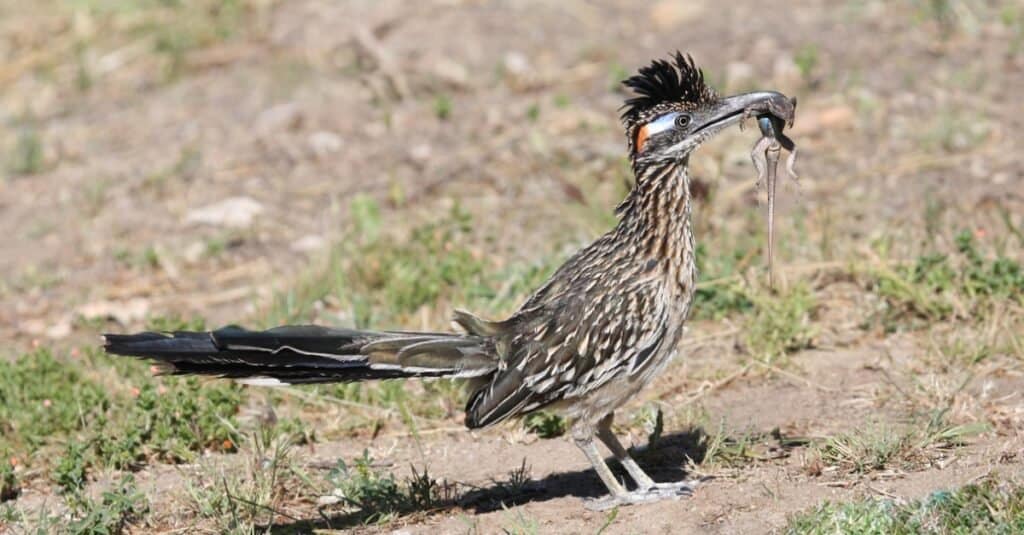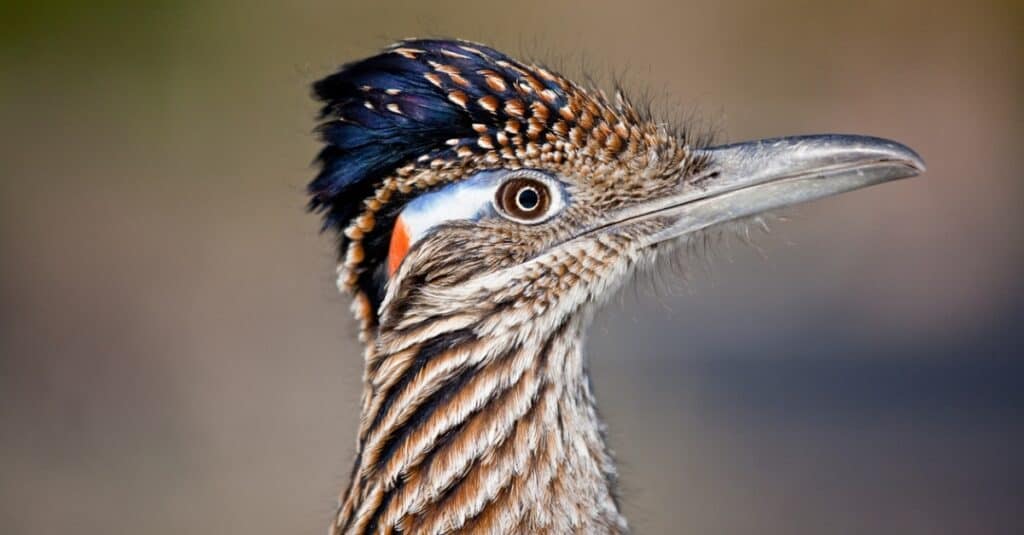For many, roadrunners are synonymous with Saturday morning cartoons. They are incredibly fast runners. They can even outdistance humans, though coyotes are actually faster than roadrunners. Roadrunners generally live in hot, dry deserts, and don’t fly much. So, with all this speed, heat, and ground, just what do roadrunners eat?
Here, we’ll answer the question of what roadrunners eat. We’ll learn how they hunt, what they eat in the winter months, and even what they feed their babies. Then, we’ll explore the differences between the two species of roadrunner, and how their diets compare.
What Do Roadrunners Like to Eat?

Roadrunners eat small mammals,
lizards
, and snakes. They are omnivores
©iStock.com/NaturesDisplay
Roadrunners eat a diet rich in small mammals, lizards, and insects, as well as fruit and seeds. They are opportunistic omnivores. Roadrunners are excellent hunters, and will eat almost any living thing they find on the ground, even bird eggs. Roadrunners are one of the few creatures that actively hunt and eat rattlesnakes. A few of the roadrunner’s favorite foods are:
- Insects: including black widow spiders, centipedes, millipedes, grasshoppers, crickets, caterpillars, beetles, mealworms, snails, cockroaches, mosquitos, dragonflies, and tarantulas.
- Lizards
- Scorpions
- Snakes, including rattlesnakes
- Young ground squirrels
- Mice
- Birds: including quail, sparrows, songbirds, hummingbirds, and other roadrunners
- Carrion (dead animals)
- Eggs
- Fruit
- Seeds
Roadrunners eat mostly small living things, but they will also eat fruit and seeds if prey is scarce. Fruit comes primarily from the prickly pear cactus and sumac plants, while seeds may be foraged on the ground. Roadrunners have also been observed eating carrion, particularly on the side of the road. Though they prefer live prey, roadrunners will not say no to reptile or bird eggs if they come across them in their foraging.
How Do Roadrunners Hunt?
Roadrunners are excellent hunters. They spend their days speed-walking, looking for prey. When they catch sight of something that could make a good meal, they sprint at top-speed towards the unfortunate creature. Once close enough, they pounce. If the prey is small enough, and won’t fight back, the roadrunner usually swallows it as quickly as it can. Roadrunners will even target flying creatures, and have been known to jump straight up into the air to catch a bird or an insect.
Roadrunners are famous in the desert for their ability to hunt, kill, and eat rattlesnakes. Roadrunners eat many snakes, though they prefer those that are less than 18 inches long. When the roadrunner finds a snake, they crouch low and circle it. Then, they move closer, and puff up their wings. Their tail feathers point straight up in the air. They move their tail feathers from side to side as they circle the snake to confuse it.
Every time the snake strikes, the roadrunner jumps backwards in the air, avoiding a lethal bite. Once the roadrunner has the snake dialed in, they strike. The roadrunner waits for the snake to strike, dodges, and grabs the snake by the back of the head. Once in the roadrunner’s beak, the snake has little hope. The roadrunner finishes the job by bashing the snake’s head against the ground or a rock.
Roadrunners have to be extremely careful around poisonous creatures, like rattlesnakes and scorpions. They are not immune to venom, and will die if bitten and injected. That is why roadrunners have become such good hunters, they have to be.
The Diets of Lesser vs. Greater Roadrunners

There are two species of roadrunner; the Lesser Roadrunner and the Greater Roadrunner
©iStock.com/peterjquinn
Not all roadrunners hunt rattlesnakes. There are actually two distinct species of roadrunner; the Greater Roadrunner, and the Lesser Roadrunner.
The greater roadrunner, which lives in the desert south of the United States and Mexico, reaches up to two feet in length, and has a formidable beak. The lesser roadrunner, which lives further south in the tropical lowlands of Central America, is its smaller cousin. The lesser roadrunner tops out at about 18 inches long, and has a beak much smaller than the greater roadrunner’s.
These differences in overall size and beak size lead to some pretty interesting dietary differences. The greater roadrunner eats anything it finds; from snakes to young ground squirrels, no small creature is safe. But the lesser roadrunner, though it can run just as fast as its bigger cousin, confines itself to smaller prey.
The lesser roadrunner eats mostly insects. Grasshoppers and caterpillars make up most of its diet. Like the greater roadrunner, the lesser roadrunner will also supplement its diet with carrion, eggs, fruits, and seeds.
What Do Roadrunners Eat in the Winter?
Desert winters can be harsh. Small game disappear, and insects become scarce. So how do roadrunners survive the cold months? They survive using a couple of different methods.
First, they go into something called torpor for long hours. Torpor is a state where the body cools down, the heart rate slows, and metabolism comes close to shutting down. By doing this, roadrunners conserve energy, meaning they require fewer calories and therefore have less need to hunt.
But roadrunners have one more trick up their sleeve when it comes to surviving the winter; they eat their vegetables. Roadrunners are opportunistic omnivores, which basically means they aren’t picky eaters. In the winter months, when all the snakes have gone into hibernation, and critters don’t run around, the roadrunner eats mostly fruit and seeds.
What Do Baby Roadrunners Eat?

Roadrunners bring food to their chicks until they are around two months old
©iStock.com/jzabloski
Roadrunners are monogamous and mate for life. When their eggs hatch, the adults bring food to the babies for the first few weeks of life. During that time, the baby roadrunners are completely dependent on their parents for food. At just a few weeks old, the babies leave the nest and begin accompanying their parents on hunting trips. They stay with the adults for a few weeks more, learning how to hunt, before leaving for good.
The photo featured at the top of this post is © iStock.com/Frank Fichtmüller
Thank you for reading! Have some feedback for us? Contact the AZ Animals editorial team.






